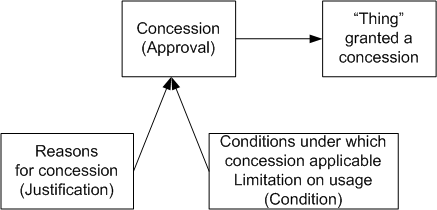
| Capability (C046):— representing_variance | Date: 2007/06/22 12:22:11 Revision: 1.30 |
This section provides a business level overview of this capability.
This capability represents a record of where the Product or Activity varies from the original intent and authorization and conditions for continued use has been granted.
This is illustrated in Figure 1 which shows conceptually how the authorization is represented.

This section provides an overview of the information model that supports this capability.
The EXPRESS-G for the activity model is shown in Figure 2 below and explained in the following sections.
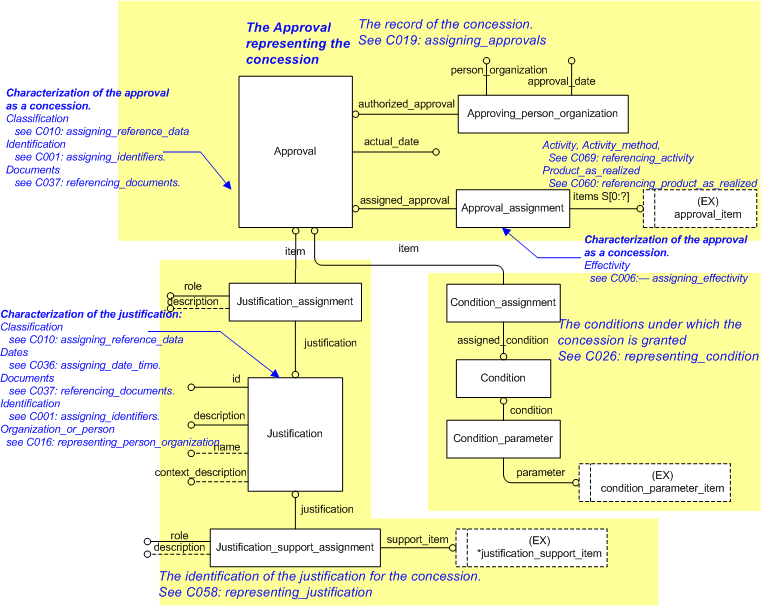
A concession is represented by an Approval that is assigned (using Approval_assignment) to the subject of the concession. Typically the subject is a Product_as_realized or a planned activity (Activity). The Approval and Approval_assignment are classified as "Concession" (urn:plcs:rdl:std:Concession) (Classification and reference data is described in C010: assigning_reference_data). The Approval representing the concession will have a status associated with it indicating whether the concession has been approved or not. See C019: assigning_approvals for details on assigning approvals. The possible approval status are represented by the following classes stored as reference data:
An example of a concession is shown in Figure 3. This shows part (A) which should have a 1mm hole in it. The operator made an error and a 1.1 mm hole is the result. This is noticed and a concession is raised to check whether this can be used. The concession is approved with no limitations. The concession is represented by Approval (#1) and Approval_assignment (#2), and is granted against the Product_as_realized (#9).
NOTE Only the main entities required for representing a concession are shown in order to simplify the diagram.
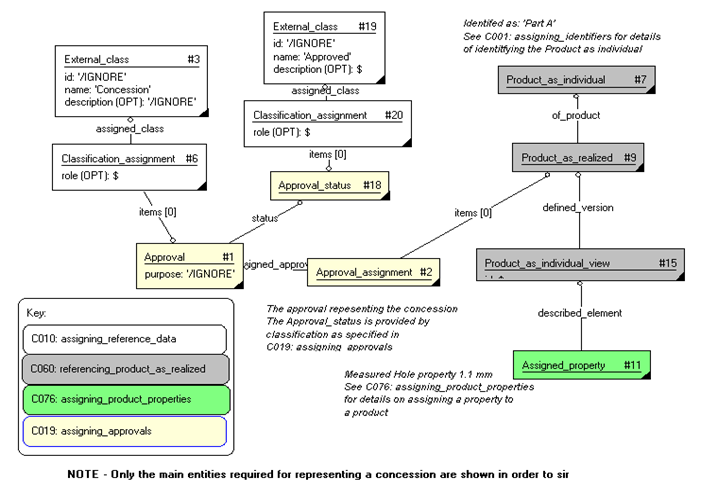
The basic template for concessions which can represent the scenario above can be found in assigning_concession and is illustrated from Figure ![]() Error Fig 2: There is no figure with id asg_conc_tmp_expnd.png
Error Fig 2: There is no figure with id asg_conc_tmp_expnd.png
through to Figure ![]() Error Fig 2: There is no figure with id asg_concession.png
Error Fig 2: There is no figure with id asg_concession.png
.
NOTE
An expansion of the template to most of the entity instances can be seen in Figure ![]() Error Fig 2: There is no figure with id asg_conc_inst_all.png
Error Fig 2: There is no figure with id asg_conc_inst_all.png
.
The underlying reasons for the concession or waiver being granted may be based on performance measurements made on the product or may be an observed state of the product. These reasons are represented by a Justification that is assigned to the Approval by a Justification_assignment. The Justification_assignment is classified as a "Concession justification" (urn:plcs:rdl:std:Concession justification), or other appropriate sub-class of "Justification assignment role" (urn:plcs:rdl:std:Justification assignment role). The reasons for the waiver, such as the observed state or performance measure are recorded by assigning them to the Justification by a Justification_support_assignment which is also classified as a "Concession justification" (urn:plcs:rdl:std:Concession justification), or other appropriate sub-class.
The basic template for assigning justifications which can represent the scenario above can be found in assigning_supported_justification![]() Error T1: DEX assigning_supported_justification not in Dexlib
Error T1: DEX assigning_supported_justification not in Dexlib
and is illustrated in
Figure ![]() Error Fig 2: There is no figure with id asg_just_ent_inst1.png
Error Fig 2: There is no figure with id asg_just_ent_inst1.png
, Figure ![]() Error Fig 2: There is no figure with id asg_just_ent_inst_char.png
Error Fig 2: There is no figure with id asg_just_ent_inst_char.png
, and Figure ![]() Error Fig 2: There is no figure with id asg_just_tmp_inst1.png
Error Fig 2: There is no figure with id asg_just_tmp_inst1.png
.
The reasons for a concession may also be recorded in documents, in
which case the document
(Document)
is assigned to the
Approval representing the
concession by a
Document_assignment
which is classified as a
[Documented_concession]![]() Error RDL1: The class Documented_concession does not exist in RDL at URI urn:plcs:rdl:std. Check the dexlib/data/refdata/rdl_index.xml
Error RDL1: The class Documented_concession does not exist in RDL at URI urn:plcs:rdl:std. Check the dexlib/data/refdata/rdl_index.xml
. There may be more than one document describing the
"Concession"
(urn:plcs:rdl:std:Concession). These documents may also be related together. Details of representing documents is provided in
C005: representing_documents. The assignment of the document can be achieved by use of the template assigning_document and is an optional characterization of the
assigning_concession template - and is illustrated in
Figure ![]() Error Fig 2: There is no figure with id asg_conc_inst.png
Error Fig 2: There is no figure with id asg_conc_inst.png
.
An instance diagram showing a concession and the reasons for the concession is shown in Figure 4. The concession is represented by Approval (#1) and Approval_assignment (#2), and is granted against the Product_as_realized (#9).
The reason for the concession being granted is that the part (Product_as_realized (#1)) has a 1.1 mm hole in it which is in tolerance. (The hole is represented by an Assigned_property (#11). Details of representing product properties are provided in C076: assigning_product_properties). This provides justification for the concession. This is represented by the Justification (#12) instance being linked to the Assigned_property (#11) by the instance Justification_support_assignment (#14). The Justification (#12) is then assigned to the approval representing the concession by Justification_assignment (#13).
In addition to or an alternative to using
Justification (#12)
the reasons for the concession can also be recorded in a document
(Document (#17)) which is assigned to the
Approval (#1) representing the
concession by the
Document_assignment (#16). The assignment of the document in this case shall be of type
[Documented_justification]![]() Error RDL1: The class Documented_justification does not exist in RDL at URI urn:plcs:rdl:std. Check the dexlib/data/refdata/rdl_index.xml
Error RDL1: The class Documented_justification does not exist in RDL at URI urn:plcs:rdl:std. Check the dexlib/data/refdata/rdl_index.xml
to distinguish it from other documents.
NOTE Only the main entities required for representing a concession are shown in order to simplify the diagram.
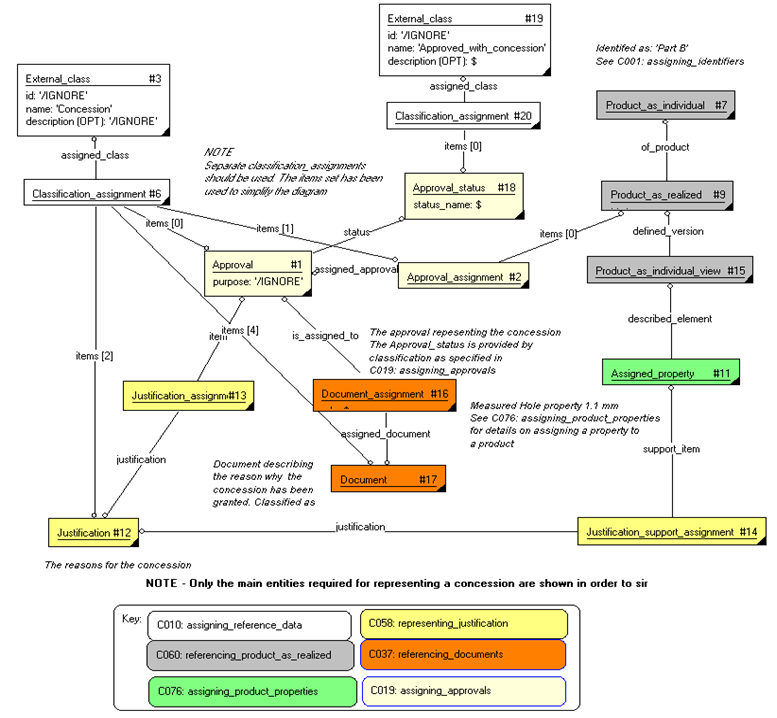
In many cases, the concession will be granted with an associated restriction for use. For example, a part (B) should have a 1mm hole in it. The operator made an error and a 1.1 mm hole is the result. This is noticed and a concession is raised to check whether this can be used. The concession is approved, however with the limitation that it can only be assembled into an aircraft that will not fly in conditions above 25 degrees C.
The restriction is represented either by Document and/or by using Conditions.
Documented conditional concessions
When a document is used to record the condition under which the
concession is given, the document
(Document)
is assigned to the
Approval representing the
concession by a
Document_assignment
which is classified as a
[Documented_condition]![]() Error RDL1: The class Documented_condition does not exist in RDL at URI urn:plcs:rdl:std. Check the dexlib/data/refdata/rdl_index.xml
Error RDL1: The class Documented_condition does not exist in RDL at URI urn:plcs:rdl:std. Check the dexlib/data/refdata/rdl_index.xml
to distinguish it from others.
Details of representing documents is provided in
C005: representing_documents.
An example showing the use of a document to represent the condition
of usage as described for part (B) above is shown in Figure 5.
This shows Part (B)
(Product_as_realized (#9)).
fitted to an aircraft.
Product_as_realized (#23).
The concession is represented by
Approval (#1)
and assigned to / against Part B by
Approval_assignment (#2).
This concession places a restriction on the aircraft to which the
part is fitted, so the
Approval (#1)
and assigned to / against Part B by
Approval_assignment (#2).
This restriction is described in the
Document (#26)
which is assigned to the concession
(Approval (#1))
by the
Document_assignment (#27).
The
Document (#26)
should be classified as a [Documented_condition]![]() Error RDL1: The class Documented_condition does not exist in RDL at URI urn:plcs:rdl:std. Check the dexlib/data/refdata/rdl_index.xml
Error RDL1: The class Documented_condition does not exist in RDL at URI urn:plcs:rdl:std. Check the dexlib/data/refdata/rdl_index.xml
.
The assignment of the document can be achieved by use of the template assigning_document and is an optional characterization of the
assigning_concession template - and is illustrated in
Figure ![]() Error Fig 2: There is no figure with id asg_conc_inst.png
Error Fig 2: There is no figure with id asg_conc_inst.png
(modifying the classification in the example as required).
NOTE Only the main entities required for representing a concession are shown in order to simplify the diagram.
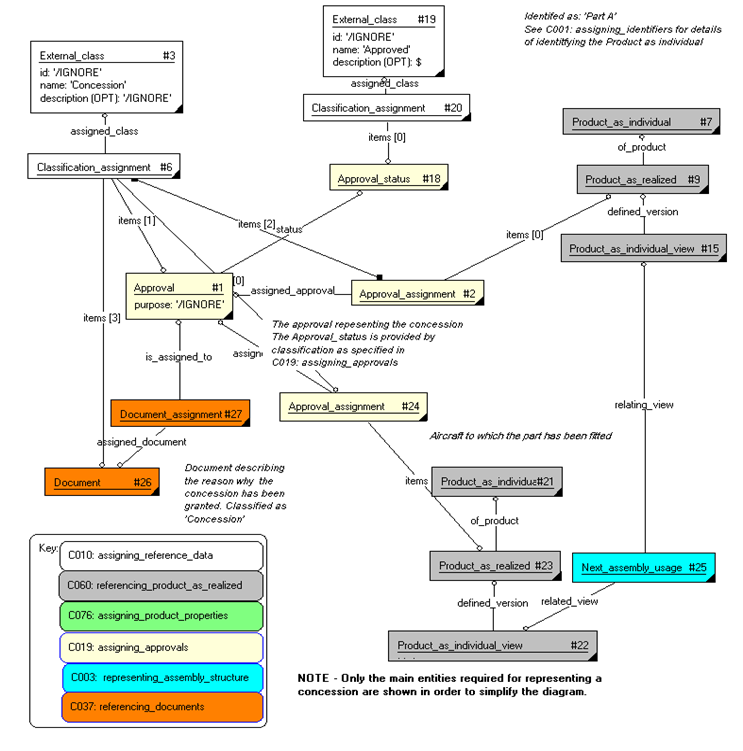
Explicit conditional concessions
When the condition under which the concession is given is to be made explicit, a Condition is assigned to the Approval representing the concession by a Condition_assignment. The Condition_assignment is classified as a "Concession condition" (urn:plcs:rdl:std:Concession condition). The inputs to the condition are represented by Condition_parameter. The use of condition is described in C026: representing_condition.
In other words, the Condition is used to represent the limitations, which if met, mean that the concession is approved.
This is illustrated in Figure 6 which shows Part (B) (Product_as_realized (#7)) fitted to an aircraft Product_as_realized (#23). The concession is represented by Approval (#1) and assigned to / against Part B by Approval_assignment (#2). This concession places a restriction on the aircraft to which the part is fitted, so the Approval (#1) is assigned to / against Part B by Approval_assignment (#24).
The concession is granted if the aircraft to which part (B) is fitted will not fly in conditions above 25 degrees C. This conditional concession is represented by Condition (#28) assigned to the concession, Approval (#1), by the Condition_assignment (#29). In other words, the concession is approved if the condition is met. The parameter of the concession is the operating temperature of the aircraft represented by the Assigned_property (#31). If this is below the 25 degrees C then the concession is granted.
The basic template for assigning conditions which can represent the scenario above can be found in assigning_condition and is illustrated in
Figure ![]() Error Fig 2: There is no figure with id basic_cond_tmp_ents.png
Error Fig 2: There is no figure with id basic_cond_tmp_ents.png
toFigure ![]() Error Fig 2: There is no figure with id basic_cond_tmp_insts.png
Error Fig 2: There is no figure with id basic_cond_tmp_insts.png
.
NOTE
The expression "below the 25 degrees C" is represented as the
description attribute of a
Document attached to an instance of
Condition (#28).
I.e. in a non computer interpretable form. This is illustrated as part of the template arrangement depicted in
Figure ![]() Error Fig 2: There is no figure with id basic_cond_tmp_ents.png
Error Fig 2: There is no figure with id basic_cond_tmp_ents.png
and Figure ![]() Error Fig 2: There is no figure with id basic_cond_ent_insts.png
Error Fig 2: There is no figure with id basic_cond_ent_insts.png
.
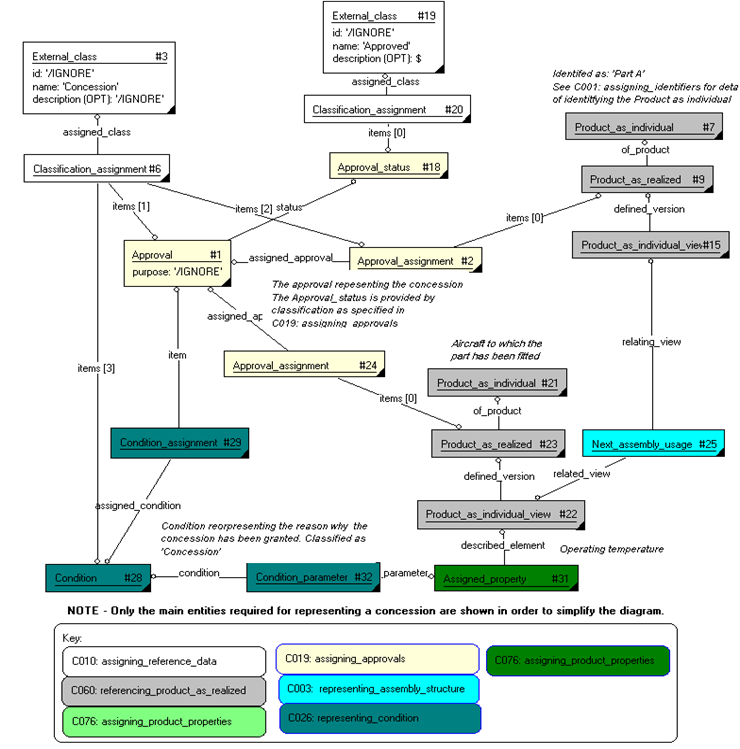
The concession, represented by an Approval, is identified by assigning it an identifier through the use of Identification_assignment.
NOTE Identification is described in C001: assigning_identifiers.
Assigning a Person or Organization
The person or organization who authorized the concession is represented by using an Approving_person_organization to assign a Organization or Person_in_organization to the Approval representing the concession
The date when the concession was granted is represented by the date on the actual_date attribute on the Approval.
NOTE The representation of dates is described the capability C036: assigning_date_time.
Limiting duration of concession by effectivity
The time period over which a concession is effective can be set by the assigning a Dated_effectivity to the Approval representing the concession, by using an Effectivity_assignment.
NOTE The use of effectivity is described in the capability: C006: assigning_effectivity.
The following sections define a set of templates for the capability, where a template is a specification of a set of entities that need to be instantiated to represent a given set of information.
This section specifies the template assigning_concession.
NOTE An explanation of a template and the associated instantiation path is provided in the Template overview section.
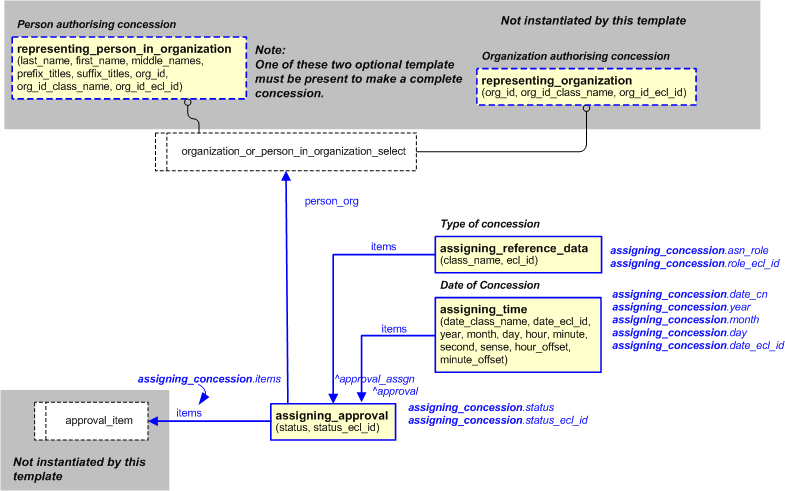

target
is the parameter to which the
Approval
is bound.
target
is the parameter to which the
Approval_assignment
is bound.
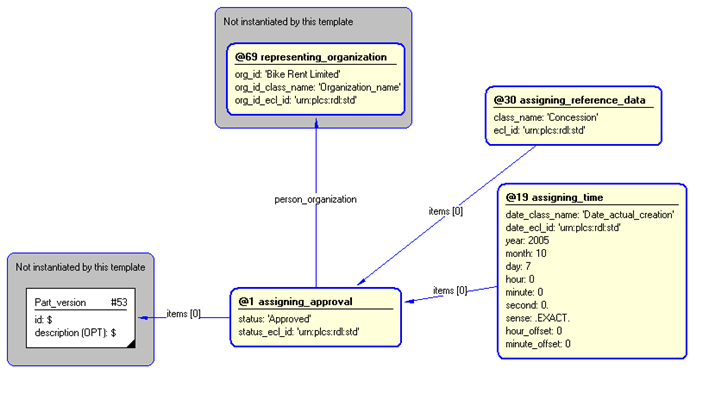
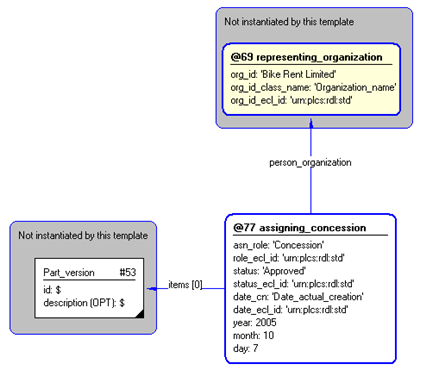
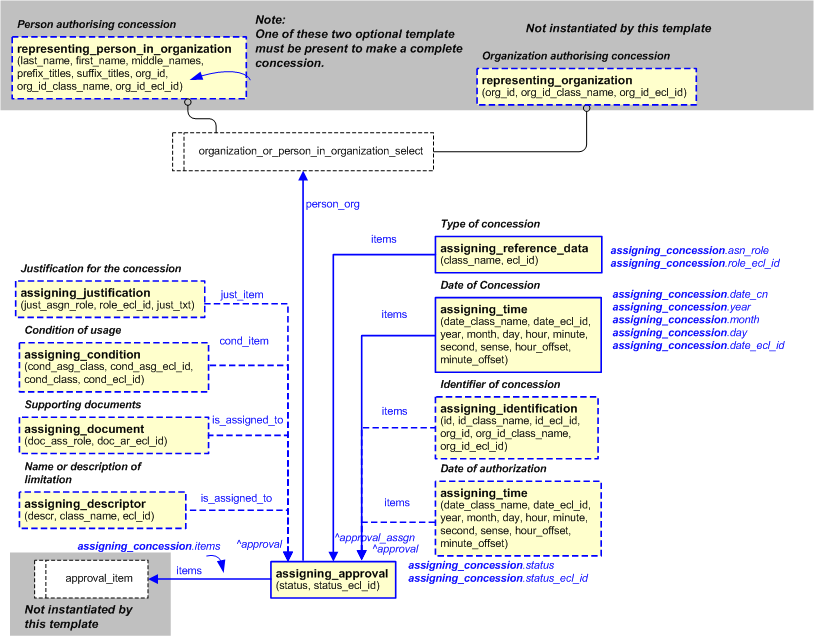
NOTE this characterization is optional.
Dates can be associated with the concession, in a given role, by using the template assigning_time.
These are applied to the ^approval reference parameter. See Figure 5 for the an abstract view of this.
One date is commonly assigned to the template assigning_concession, namely the actual sign off date on which the concession approval was authorized.
NOTE this characterization is optional.
Identifiers can be associated with the concession by using the template assigning_identification.
These are applied to the ^approval reference parameter. See Figure 5 for the an abstract view of this.
NOTE this characterization is optional.
Names or descriptions can be associated with the concession by using the template assigning_descriptor.
These are applied to the ^approval reference parameter. See Figure 5 for the an abstract view of this.
NOTE this characterization is optional.
Documents describing the reason for a "Concession" (urn:plcs:rdl:std:Concession) can be attached to an Approval by using the template assigning_document.
These are applied to the ^approval reference parameter. See Figure 5 for the an abstract view of this.
NOTE this characterization is optional.
Conditions of the usage of an item caused by the "Concession" (urn:plcs:rdl:std:Concession) can be attached to an Approval by using the template assigning_condition.
These are applied to the ^approval reference parameter. See Figure 5 for the an abstract view of this.
NOTE this characterization is optional.
Justifications for the "Concession" (urn:plcs:rdl:std:Concession) can be attached to an Approval by using the template assigning_justification for the justification.
These are applied to the ^approval reference parameter. See Figure 5 for the an abstract view of this.
This capability "Representing a variance" is related to the following capabilities:
This capability "Representing a variance" is dependent on the following capabilities:
The following classes of reference data are required for this capability:
© OASIS 2010 — All rights reserved